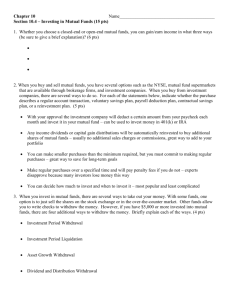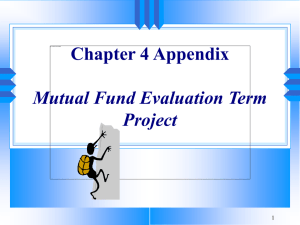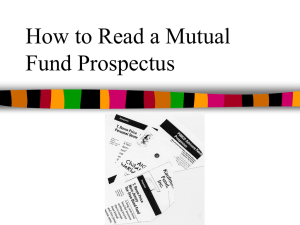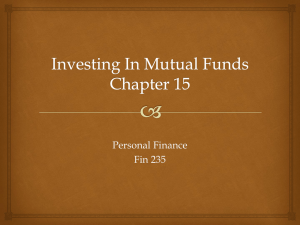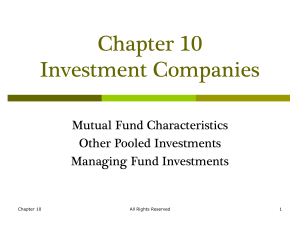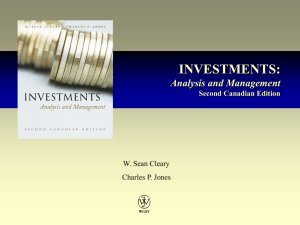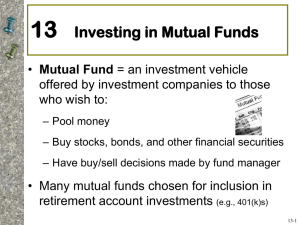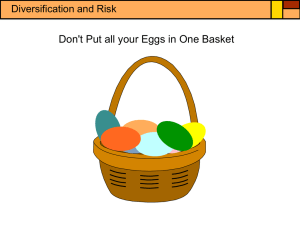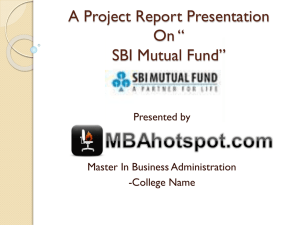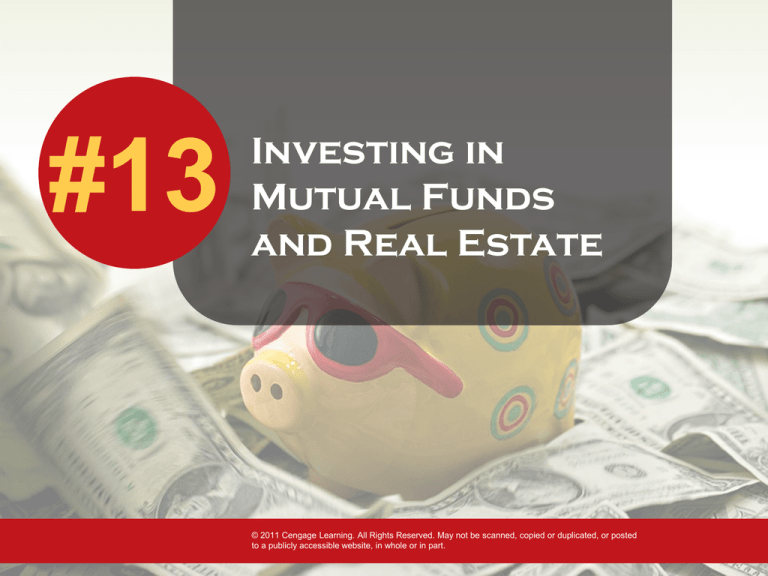
#13
Investing in
Mutual Funds
and Real Estate
© 2011 Cengage Learning. All Rights Reserved. May not be scanned, copied or duplicated, or posted
to a publicly accessible website, in whole or in part.
Mutual Fund: Some Basics
• Financial services organization that
receives money from shareholders
and invests it on their behalf
• Investors become part owners in
a securities portfolio
More people invest in mutual
funds than any other financial product
The Mutual Fund Concept
Pooled diversification
• Investors buy into a diversified
portfolio of securities for the
collective benefit of individual
investors
Basic Mutual Fund Structure
Why Invest in Mutual Funds
• Diversification
• Professional
Management
• Financial Returns
• Convenience
But remember - No choice in securities selection
No control over sale of securities within fund
How Mutual Funds are
Organized and Run
•
•
•
•
•
Each fund is a separate corporation or
trust owned by shareholders
Management company - runs daily operations
Investment advisor - oversees portfolio
Distributor - sells fund shares
Custodian - safeguards fund’s assets
Transfer agent - executes transactions and
maintains shareholder records
Types of Investment
Companies
Open-End Investment Companies
• “Mutual fund” commonly denotes this type
of investment company
• Shares purchased from and sold back to
company
– not traded among individual investors
• New shares issued as money flows in
• NAV is usually the quoted price
Open-End versus Closed End
Open-End Investment
Companies
• “Mutual fund”
commonly denotes this
type of investment
company
• Shares purchased
from and sold back to
company
• New shares issued as
money flows in
• NAV is quoted price
Closed-End Investment
Companies
• Fixed number of shares
• Trading between
investors in market
• Shares are listed and
trade at a discount or
premium to NAV
Net Asset Value (NAV)
Net value of all securities held
in fund’s portfolio
NAV =
current price of fund assets - liabilities
number of outstanding shares
Exchange-Traded Funds (EFT)
• Typically structured as index funds
– Spiders based on S&P 500
– Diamonds based on DJIA
– Qubes based on Nasdaq 100
• Trade on listed exchanges like closed-end funds
• Numbers of shares change like open-end funds
Important Cost Considerations
Load and No-load Funds
• Load funds charge a commission
when purchased (Front-end load)
or sold (Back-end load)
• No-load funds charge no
commission
Important Cost
Considerations
• 12(b)-1
Fees annual
fees for
marketing
and
promotion
• Management
Fees - annual
fees charged
by all funds to
pay the fund
manager
Types of Funds
•
•
•
•
•
•
•
Growth
Aggressive Growth
Value
Equity-Income
Balanced
Growth & Income
Bond
•
•
•
•
Money Market
Index
Sector
Socially
Responsible
• International
• Asset Allocation
Bond Funds
•
•
•
•
•
•
•
Government bond funds
Mortgage-backed bond funds
High-grade corporate bond funds
High-yield corporate bond funds
Convertible bond funds
Municipal bond funds
Intermediate-term bond funds
Money Market Mutual Funds
• General-purpose money funds
• Tax-exempt money funds
• Government securities money funds
All highly liquid, low risk
Index Funds
• Rather than beat the
market index funds try
to match the market
• Buy and hold
Sector Funds
• Restricts investments to a particular
sector of the market
• Popular sectors include real estate,
technology, financial services, natural
resources, electronics,
telecommunications, and health care
Socially Responsible Funds
• Invests only in firms meeting certain
moral, ethical, or environmental factors
• Exclude tobacco, alcohol, gambling,
weapon contractors, nuclear power
plants
Other Fund Types
International
Funds
• Most or all of its
investing is in
foreign securities
Asset Allocation
Funds
• Spread investor’s
money across
different market
types
Services Offered by
Mutual Funds
• Automatic Investment Plan - mutual fund
periodically drafts money from investor's bank
account
• Automatic Reinvestment Plan - fund
earnings and distributions automatically
reinvested in additional shares of fund
• Regular Income - fund automatically pays
out predetermined amount to investor
Reinvesting Income
Services Offered by
Mutual Funds
Conversion
Privileges
• shareholders
easily move from
one fund to
another within the
fund family
Retirement
Plans
• funds set up
and administer
retirement
plans
Making Mutual Fund Investments
The Selection Process
• Decide which funds to buy
by assessing your needs
• Consider your investment
objectives
• What is your intended
use of the fund
• What services are
important to you
Measuring Fund Performance
•
•
•
Returns consist of
Dividend income
Capital gains distributions
Change in fund's share price
Past performance does not
guarantee future returns
Measuring Fund Performance
•
•
Return is made up of
–
net investment income fund earns from
dividends and interest
–
realized and unrealized capital gains fund earns
Mutual funds provide a standardized format
that highlights key income, expense, capital
gains information
Income and Capital Changes
Investing in Real Estate
• Provides greater diversification than
does holding just stocks or bonds
• Less volatility than stocks
• Doesn’t move in tandem with stocks
Some Basic Considerations
• Cash flow and taxes
– Depreciation write-offs reduce taxes
– Passive investment
• Appreciation in value
• Use of leverage
– Borrowed money
magnifies returns
Investing in Income Property
Commercial property
• Office buildings,
industrial space,
warehouses, retail
space, hotels
Residential property
• Homes, apartments,
small multifamily
buildings
Other Ways to Invest in
Real Estate
Real Estate Investment Trusts (REITs)
• Closed-end investment companies holding real estate
• Offer diverse, marketable way to invest in real estate
–Equity REITs invest in properties
–Mortgage REITs invest in mortgages
–Hybrid REITs invest in both
Real estate limited partnerships (LLCs)
• Limited liability partnerships

